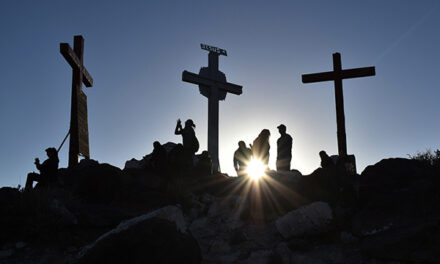Sabinal
For almost 25 years, Bertha Sisneros-Torres of Sabinal has made a difference in the lives of the true New Mexican natives. So when Governor Gary Johnson appointed her to the New Mexico Commission on Indian Affairs, she realized that her hard work had been noticed and appreciated.
Sisneros-Torres is serving her second term on the commission and says that the experience has been both gratifying and a learning experience.
“I have been working with tribes for a number of years,” she said. “I’ve earned a degree of trust, and I’ve learned not to ask certain questions and to not infringe on certain private matters. I’ve learned to sit back and be patient and just listen and observe.”
Sisneros-Torres first became involved in working with Native American tribes while she was a law student at the University of New Mexico. She was hired by former New Mexico Senator Joseph Montoya in 1978 as a legislative assistant and ended up specializing in tribal government issues.
The Sabinal woman said that, if it wasn’t for Montoya’s dedication to tribal issues, she wouldn’t have dedicated her life to the cause. While working with the senator in Washington, D.C., Sisneros-Torres began learning what the real issues were that tribes were facing — not only in New Mexico but all over the country.
“They were dealing with a lot of the same issues they are facing today, including sovereignty, government-to-government relationships, economic development for housing and other funding concerns, such as education,” she said. “But the government-to-government relationship issue was really the big issue. The Indians wanted a direct relationship with other governments, and they were and still are striving for that kind of recognition.”
Sisneros-Torres said it was Montoya’s dedication and commitment that led her to a life devoted to helping Native Americans. After leaving Washington, she came back home to New Mexico where she continued to act as an advocate.
She worked for the All Indian Pueblo Council, the Navajo Nation, the American Indian School of Medicine and for Navajo Pueblo Chairman Peter Zenza and the Hopi tribe.
Sisneros Torres also was key in forming a joint contract between the Navajos and Hopi in talks on helping the two tribes reconcile their differences and reach a resolution.
Because of her willingness and desire to advocate, Sisneros-Torres decided it was time to use her skills for the benefit of both the Native Americans and herself. After working with a firm that was doing business with the tribes, she started her own company, Parker and Associates Corporation, which provides public relations and legislative liaison services, grant writing, troubleshooting and prepares tribes for federal funding.
“I’ve had the fortunate opportunity to build a rapport with the tribes and gain their confidence,” she said. “It’s not that easy to gain the confidence of the tribes because there’s a process that’s involved. If you’re in a big rush, it won’t work because they have a culture that is different that we’re not used to.
“One of the things that I’ve found out is that some of the things that the government is asking for can be misinterpreted because of the differences in languages — there’s a cultural difference there,” Sisneros-Torres said. “That’s something that the U.S. government hasn’t learned yet. They haven’t learned how to talk to tribal leaders and to listen to what tribes really want. They use words that are totally foreign and have different meanings. It makes it very difficult for the tribes.”
The New Mexico Commission on Indian Affairs works as a liaison, or a clearinghouse, on Native American issues for the state.
This commission is unlike any other commission dedicated to Native American issues in that the legislature has provided them the authority to establish policy and regulations regarding Native American matters. The commission also has subpoena powers and can call hearings about any particular issue that needs to be clarified.
As an outspoken member of the commission, Sisneros-Torres has voiced her opinion on different issues, including Indian gaming in New Mexico.
“I personally feel that, when it came to gaming issues, the commission possibly had an opportunity to intervene in the issue, and they may still have those powers,” she said. “If we have the power to advise and be a clearinghouse, if there are any dollars being appropriated from Indian tribes, then it seems to me that it would be only appropriate that the New Mexico Commission on Indian Affairs decide how those dollars are going to be spent.”
Education is another issue that Sisneros-Torres has advocated for many years. She said that, although the new “No Child Left Behind” act, which was recently signed into law, is a step in the right direction, she believes lawmakers inadvertently overlooked the tribes.
“There are areas of concern, including issues of privatization of schools,” she said. “Their intent was good, but I want to make sure that the process will continue to go forward.
“In the tribes, you have BIA managed schools, public schools and privatized schools. The tribes are soverign governments, and when another goverment comes in and tells the tribes that they have to privatize their schools, it’s an infringment on their treaties and on their government-to-government relationship.”
With only a few more years on her term on the commission, Sisneros-Torres says she will continue her work with the tribes. She said she has committed herself to support their future and, at the same time, preserve their past.
“I have a really deep feeling for Indian people, and I admire them,” she said. “I got to understand their government, their religion and the culture. Everything ties in so perfectly, and it’s very ideal. Their history is part of our history, and we have no history without theirs.”
Clara Garcia is the editor and publisher of the Valencia County News-Bulletin.
She is a native of the city of Belen, beginning her journalism career at the News-Bulletin in 1998 as the crime and courts reporter. During her time at the paper, Clara has won numerous awards for her writing, photography and typography and design both from the National Newspaper Association and the New Mexico Press Association.

















